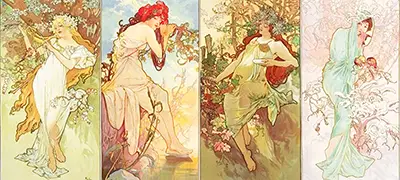Some observations of the course of Art during the Art deco period.
Art has always been controversial. Where there are boundaries and rules there are disagreements. Modern Art officially began somewhere in the middle of the 19th Century in France, with experiments firstly by the Realists in depicting parochial, everyday scenes which was subject matter that offended the higher echelons of society. From that time on, the Art of the Western world, not unlike its parallels in music, delivered challenge after challenge to established traditions and audiences, many with an aversion to the imposed changes.
Modernism, a term that is used loosely to encompass the huge changes brought largely by the Industrial Revolution, specifically refers to the experimentational styles of painting and design at the dawn of the 20th century. The years from 1920 to 1940 were particularly tumultuous in Australian Art, as much debate became heated over what was appropriate or authentic Modernist Art.
Modernism is more than a vague, generic term such as “modern art”. Modernism means formalism. In any art practice, be it painting, music or poetry, modernism deals with structure, privileging form over content and style over subject matter. In painting, its chief late 19th- and early 20th-century protagonists include Manet, Cezanne, Matisse and Picasso. Modernism liberated how reality was treated. The illusion of three-dimensional pictorial space was abandoned and form was fractured. The debate about modernism signified a war about culture (see article by Janine Burke for more).
Many Australian Artists moved between their homeland Australia, known as the Antipodes, and France or Britain seeking to bring fresh new developments to the nation. Women Artists too had a new standing and forceful influence on the history that was being written. A profession as a female painter was in keeping with the times but the works, often described as domestic subjects, provided a new craze for strong compositions featuring simple objects placed in an uncluttered picture plane. Picturesque bush scenes were outmoded by a fierce focus on the formal elements of art. This obsession with formalist compositions featuring strong colours, bold shapes, heavy lines and multiple viewpoints required abandoning the familiar such as pastoral scenes and sentimental portraits.
An offshoot was a raging battle between the Art Academies and their attached artists in Sydney and Melbourne. The two cities became divided camps over figurative versus non-figurative imagery and many artists moved to Melbourne for the more conservative approach while Sydney was pushing the boundaries with abstract styles that both thrilled and confused the public.
Overseas abstract art had taken hold for good, embracing fast paced movements with names such as Post-Impressionism, Dada, Cubism, Futurism, Surrealism and Expressionism in all its forms creating a new relationship between fine art, craft and design.
Art Deco the name of the style that was born of this influence was typically based on simplified shapes and an emphasis on geometry, muted colours and formal lines. Its birth was elevated by the highly publicised and revered International Exhibition of Modern Decorative and Industrial Arts in Paris in 1925. Before Art Deco, Art Nouveau was officially in vogue until 1910. Attached to the decorative arts with motifs taken from plants and animals, it aimed to create beautiful images and objects. Initially a French movement it spread from the 1880’s (‘nouveau’ being French for ‘new)’. Australian Art was turned on its ear by its lyrical, romantic and fantastical works that were more like picture book illustrations than the highbrow paintings and drawings known in Fine Art circles.
Modernism prevailed in Australia until the Second World War brought about new expressionist directions, predominantly born of the horrors of the military conflicts. Mid-century art trends pulled away from Modernism’s very structural styles with a new wit, great diversity and attachments to Pop culture and by the 1980’s the term Post-Modernism was coined to define that which has come after.
The Creative Coaching Company’s young art students have been making small paintings and designs for the Whimsical and Creative Stall at the Chelmsford Marketplace to showcase Modernism in Art.




